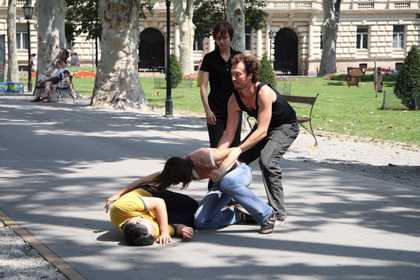Igor Grubić’s work often explores themes of intolerance in society
Grubić's film East Side Story addresses the physical and verbal abuse of participants in Gay Pride marches by organised far-right extremist groups. Grubić used television footage of a Pride march that took place in Belgrade, Serbia in 2001. He combined this with footage from a march in Zagreb, Croatia in 2002, made by a Croatian film production collective he belonged to called Studio Fade In. The left-hand screen shows edits from this footage, alternating between the two cities. Angry passers-by join the violence, appearing to unite with the extreme nationalists. On the right-hand screen, the events are re-enacted by four members of a Zagreb dance group. They were filmed in the same public spaces in which the Pride marches took place.
The dancers’ movements are based on the aggressive gestures of the extremist groups, and the body language of the Pride participants. Grubić has carefully synchronised the editing across both films. This creates moments when the violent energy of the crowds seems to be absorbed or dispersed by the dancers’ bodies. The artist has said he is ‘suggesting the presence of a vivid, creative force very much like a resistance movement that is trying to change an intolerant, conservative society into a better one’.
Croatian artist Igor Grubić has also been engaged in activism and politics for many years. His work includes making interventions in public space, working with marginalised communities, and producing socio-politically engaged films.
Content guidance: This work contains documentary footage of homophobic language and violence
Curated by Juliet Bingham

